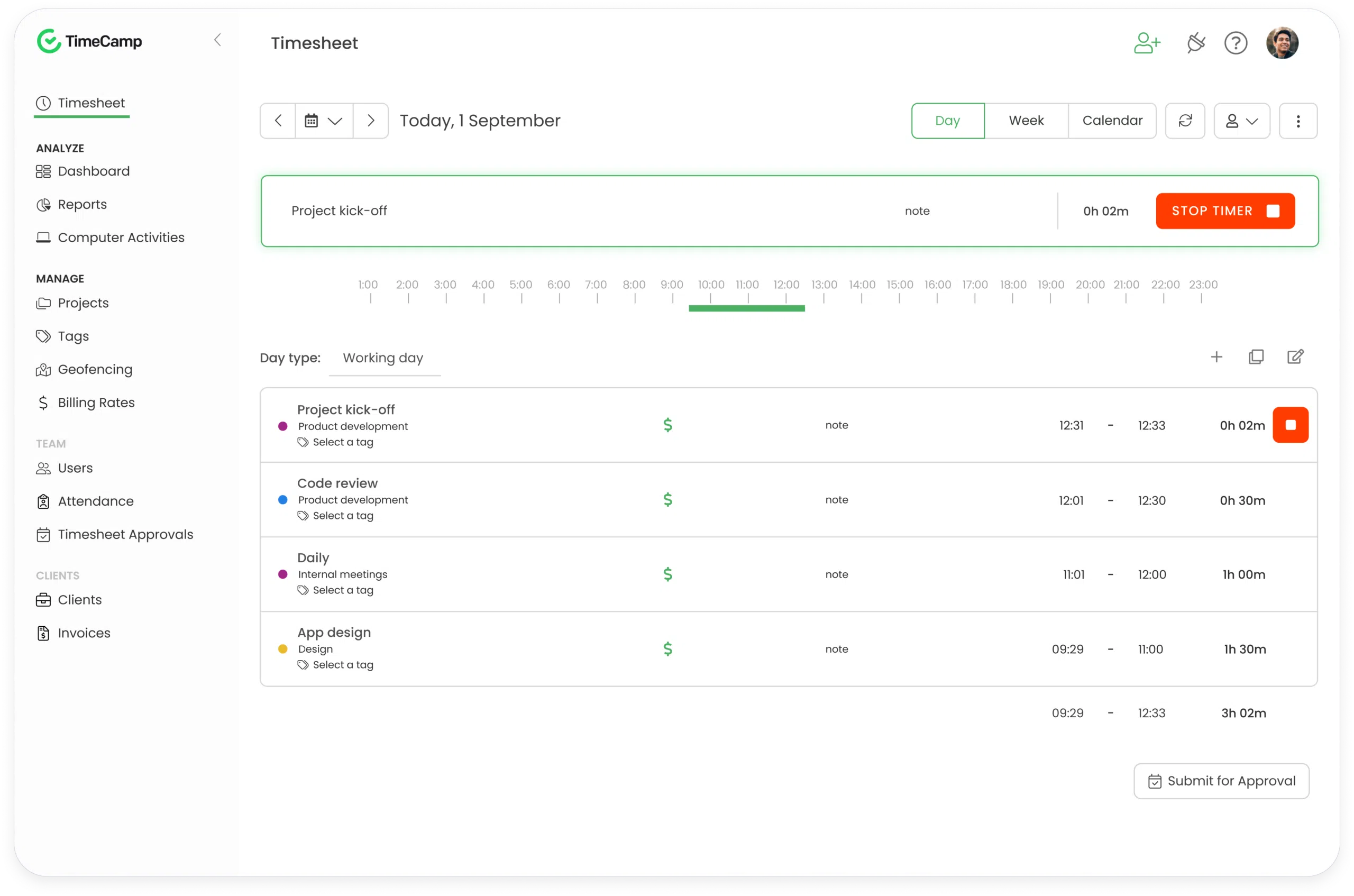How Do I Calculate My Salary Per Hour?
-
Kate Borucka
- April 2, 2024
- 6 min read

Understanding hourly salary calculations is important. Knowing your hourly rate can help you budget, negotiate salaries, or make informed career decisions.
While for hourly employees hourly wage is obvious, calculating how much you’re paid for an hour of your work as a salaried employee is more tricky. Here’s everything you need to know about estimating hourly compensation.
What Is Hourly Wage Exactly?
Some say that “time is money.” Others say that “you can’t buy time.” But the truth is somewhere in between—you can get paid for your time. Particularly, if you work as an hourly employee.
Hourly wage, aka. hourly salary, hourly pay, is the amount of money an employee is paid for each hour of work they complete. As simple as that.
Additionally, hourly workers are usually freelancers, contractors, and those who run a business and offer their professional services.
It’s important to mention that hourly employees are non-exempt employees. That means they are entitled to overtime pay and qualify for the minimum wage, as stated by the FLSA (the Fair Labor Standards Act). Additionally, they have to provide records of work, i.e., timesheets with time records for hours worked.
What Is Salary?
Salary is different from wages, which are typically paid on an hourly basis for work done. Salary is a fixed rate, usually paid on a monthly or annual basis. It’s often associated with full-time employment and is agreed upon as part of the employment contract.
As stated by the FLSA, salaried employees are exempt from receiving overtime pay even after they work more than 40 hours per week. However, there are some exceptions. Common exemptions include executive, administrative, professional, and computer employee classifications. These exemptions depend on factors like job duties and salary levels.
Salaries can vary greatly depending on factors such as the industry, level of experience, job role, location, and negotiating skills of the employee.
Why You Should Know Your Hourly Rate?
Knowing your hourly wages is a must when you work per number of hours so you can calculate hourly rate precisely. But it’s just as important when you’re a salaried employee.
And here’s why:
- Understanding your hourly rate allows you to clearly see your earning potential and equips you with financial awareness about your job, workplace, and economics.
- It helps set the right annual salary and ensures that you’re charging an amount that is fair to you and reflective of your expertise and value.
- Knowing your monthly wage can help you manage your time more effectively, allowing you to focus on what matters most in your work.
- Understanding your hourly rate can help you negotiate with clients or employers, ensuring fair compensation for your time and expertise.
- It can provide insights into your value within the market and seeking higher-paying opportunities.
Overall, knowing how much you earn per hour in your annual wage can help you decide whether to stay with your current company or make a change.
Remember, you can do the same job as a salaried, full-time employee, contractor, or freelancer. The only difference is how you get paid.
Steps to Calculate Salary Per Hour
Calculating your salary per hour involves a few straightforward steps. Here’s a guide to help you through the process:
1) Determine Your Annual Salary
Start by figuring out your annual salary. This is typically the amount you are contracted to receive for a year of work. Make sure you have the gross annual salary, which is the total salary before any deductions. This figure should reflect your pre-tax earnings for the entire year.
2) Consider Overtime and Benefits (if applicable)
Depending on your circumstances, you may need to consider additional factors such as overtime pay, bonuses, paid time off (PTO, paid leave, etc.), health insurance, or commissions. These can impact your overall hourly rate and should be factored into your calculations accordingly.
For example, if you receive 10 paid vacation days and each day is worth $100, subtract $1,000 from your annual salary.
If you’re curious about what it costs to be an employee, you can check the U.S. Bureau of Labor Statistics (BLS) section on the Employer Costs for Employee Compensation.
Read our guide on Understanding the Exact Cost of an Employee
3) Calculate the Number of Working Hours in a Year
Determine the number of hours you are expected to work in a year. This includes regular working hours per week multiplied by the number of weeks in a year.
For example, if the standard workweek is 40 hours, and there are 52 weeks in a year, the total work hours would be 40 hours/week * 52 weeks = 2080 hours.
4) Divide Your Annual Salary by the Number of Working Hours
Once you have your annual salary and the total number of working hours in a year, divide your annual salary by the number of working hours. This will give you your hourly rate.
Formula: Hourly Rate = Annual Salary / Total Work Hours
For example, if your annual salary is $50,000 and you work 2,080 hours per year:
Hourly Rate = Annual Salary / Number of Working Hours = $50,000 / 2,080 ≈ $24.04 per hour.
5) Review and Adjust as Necessary
Check if your calculations are accurate and include all required numbers. If necessary, adjust your calculations to reflect any changes in your salary or working hours.
Also, check for part-time or reduced hours. And ensure compliance with legal requirements such as minimum wage laws and any applicable state labor laws.
How Much Is… Examples of Salary to Hourly
Here are a few examples of how to calculate hourly pay. To learn your rates, replace the numbers we’ve provided with yours.
Let’s calculate the hourly rates for the provided examples:
-
How much is $40,000 a year per hour?
Hourly Rate = $40,000 / (52 weeks * 40 hours) ≈ $19.23 per hour -
How much is $50,000 a year per hour?
Hourly Rate = $50,000 / (52 weeks * 40 hours) ≈ $24.04 per hour -
How much is $60,000 a year per hour?
Hourly Rate = $60,000 / (52 weeks * 40 hours) ≈ $28.85 per hour -
$20 per hour is how much per year?
Annual Salary = $20 (52 weeks 40 hours) ≈ $41,600 per year -
$25 per hour is how much per year?
Annual Salary = $25 (52 weeks 40 hours) ≈ $52,000 per year -
$30 per hour is how much per year?
Annual Salary = $30 (52 weeks 40 hours) ≈ $62,400 per year
To overcome long manual calculations, you can use salary to hourly calculator.
Note that these calculations assume a typical full-time work schedule of 52 weeks per year and 40 hours per week. You may need to make adjustments for part-time or non-standard work schedules.
Helpful Tools to Track Hours Worked
If you want to find out how many hours you actually spend on work, you can use dedicated tools. They can help you calculate salary to hourly wage, but also monitor work time so you can better manage your time, workload, and finances.
Automatic Time Tracking – TimeCamp

TimeCamp is an automatic time tracker that records each hour worked. It’s especially useful for hourly rate-based projects but can be used by salaried employees to understand how many hours they work.
TimeCamp tracks time automatically, so you don’t have to calculate your hourly wage but can focus on your work, spot distractions and unproductive activities, and better manage time.
Additionally, TimeCamp offers a set of features that improve payroll processing, including tracking billable time, timesheets with approvals, expense tracking, invoicing, budgeting, analytics, and reporting.
Other functionalities include project and task management, tags, GPS location tracking, desktop and mobile apps, and integrations with most of the popular apps.
Additionally, TimeCamp aids in maintaining work-life balance by tracking time spent on work and personal activities.
Calculators
Calculator is the simplest tool that you can use to precisely determine hourly pay. For example, overtime pay calculator, payroll calculators, or free time card calculator.
Using complex formulas can be difficult, but the right calculator can do it for you. That way, you’ll ensure all numbers add up, prevent errors, and save money (because errors may cause legal consequences, and costs incurred by legal fines can drench your budget). Using online tools can simplify the process when you need to calculate my pay accurately.
Templates
Templates provide a structured format for recording your salary information. This helps you keep all relevant details in one place, making it easier to access and review when needed.
They keep all data accurate and help in budgeting, planning, goal setting, and staying legally compliant.
Conclusion: Do You Know How Many Hours You Work?
The numbers in your yearly salary or monthly salary may seem big, but do you really know how much you’re getting paid for your work? Many employees don’t pay attention to numbers in the paycheck. But knowing your hourly pay can make a difference.
Understanding the true extent of your work hours is pivotal in managing your time effectively and maintaining a healthy work-life balance. Being aware of your workload helps to make informed decisions about productivity and personal well-being.


